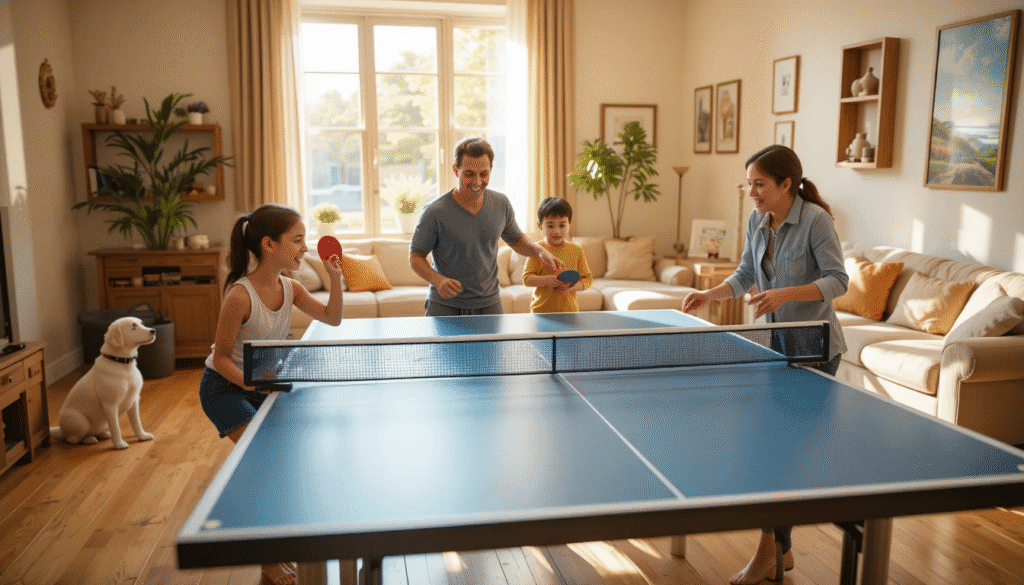You ever notice how hard it is these days to find something everyone in the family actually enjoys together? The kids want screens, the adults want quiet, and everyone’s in their own corner. That changed the day we brought home a table tennis ping pong table. Suddenly, evenings were filled with laughter, rallies, and tiny moments that turned into memories.
If you’ve ever wondered whether getting a table tennis ping pong table is worth it the answer is yes, absolutely. Here’s everything you should know before buying one, setting it up, and making it part of your home life.
Why a Table Tennis Ping Pong Table Belongs in Your Home
Bringing home a table tennis ping pong table isn’t just about buying a toy it’s about investing in a shared experience. This game bridges generations; kids can play against adults, grandparents can join in, and you don’t need special skills to have fun.
Aside from being addictive fun, it’s also a low-impact workout that improves reflexes, focus, and coordination. And let’s be honest it’s way better than everyone staring at their phones on a weekend night.
Key Features to Look For
1. Size and Dimensions
A regulation-size table tennis ping pong table measures 2.74 m x 1.525 m. But that’s just the surface you’ll also need about 2 m behind each end and 1 m on the sides to play comfortably.
If you’re tight on space, consider a foldable or compact model. Some even split into two halves for easier storage.
2. Surface Thickness and Bounce
The heart of the table is its surface. For serious play, aim for at least 18–25 mm thick. Thinner tables (12–15 mm) can work fine for beginners, but they don’t offer that crisp, consistent bounce experienced players love.
3. Frame and Build Quality
Avoid tables with weak aluminum or plastic frames. Go for steel or heavy-duty powder-coated support. A strong frame keeps your table level and wobble-free, even after hundreds of games.
4. Portability and Folding
Many modern tables come with wheel systems and folding mechanisms. If you’re setting it up in a shared space like a garage or living room, this feature is essential. Just make sure the wheels lock — a moving table mid-game can ruin the fun fast.
5. Net and Post System
Look for a sturdy, adjustable net that maintains tension. Detachable nets are easier to store and won’t stretch out quickly.
Space Planning: How Much Room You Actually Need
You’ll be surprised how much difference a few inches make in ping pong. Ideally, your play area should be around 6.7 m x 3.5 m. This gives you enough room to move freely without bumping into furniture or walls.
If you’re limited on space, you can still make it work try setting up in the garage, basement, or even under a covered patio. And always check the floor level; uneven surfaces can affect play. Use adjustable legs or rubber padding to keep things balanced.
Indoor vs Outdoor Tables
Not all tables are created equal.
Indoor tables are made with MDF or wooden tops that provide excellent bounce but are sensitive to moisture and sunlight. Perfect for basements, game rooms, or large living spaces.
Outdoor tables, on the other hand, are built from weatherproof materials like aluminum composite or melamine. They can handle rain, humidity, and temperature changes but might have a slightly different bounce feel.
If you’re unsure which to choose, go for a weather-resistant hybrid — great balance between indoor play quality and outdoor durability.
Budget vs Premium – What’s Worth Paying For
Let’s be real you can find a ping pong table anywhere from $150 to $2,000+. The difference? Quality and longevity.
- Budget options are good for casual fun but often have thinner tops and weaker frames.
- Mid-range tables ($400–$800) strike the perfect balance between quality, durability, and performance.
- Premium tables ($1,000+) deliver professional bounce, strong metal frames, and sleek folding systems.
Popular brands like STIGA, JOOLA, and Butterfly are reliable choices that offer solid warranties and replacement parts.
Setting Up Your Table Tips from Experience
Setting up your table tennis ping pong table is easier than you think, but there are a few tricks:
- Assemble on a flat surface.
- Don’t overtighten screws; wood panels can warp.
- Use a level to make sure both halves align perfectly.
- Lock the wheels and folding mechanisms before play.
- Adjust the net tension evenly — sagging nets ruin rallies fast.
We once set up ours in the garage on slightly uneven concrete one corner always bounced differently until we fixed it with rubber shims. Small details matter.
Maintenance & Care Tips
To keep your table in top condition:
- Wipe the surface after every use with a soft, dry cloth.
- Avoid strong cleaning agents; use mild soap for stains.
- Always cover it when not in use — dust and sunlight are silent killers.
- Tighten screws, inspect wheels, and check the net clips monthly.
- For outdoor tables, use a waterproof cover and store in shade.
These small steps make a huge difference in how long your table tennis ping pong table lasts.
Fun Family Games You Can Try
Sure, you can just rally but where’s the creativity in that? Try these:
- Family Tournament Night: Create mini brackets, use a scoreboard, and offer small prizes.
- King of the Table: The winner stays, new players rotate in.
- Solo Practice Mode: Fold one half and hit against it for a great reflex workout.
- Trick Shot Battles: Add spins, obstacles, or timed challenges.
Once you start, it’s addictive your home will never feel dull again.
Buying Tips & What to Avoid
- Don’t buy a table just because it’s cheap stability matters more.
- Make sure replacement parts (nets, screws, posts) are available.
- Check product reviews and warranty details before purchase.
- Avoid thin tops and wobbly legs they’ll ruin the fun quickly.
A solid, well-built table is a one-time investment that pays off in years of laughter and play.
FAQs About Table Tennis Ping Pong Tables
Q: How much space do I need?
A: Ideally 22ft x 12ft (6.7 m x 3.5 m). You can manage in smaller spaces with compact tables.
Q: Can I keep my table outside?
A: Only if it’s made for outdoor use. Indoor tables warp when exposed to humidity or sunlight.
Q: How thick should the tabletop be?
A: 18–25 mm for best bounce. Anything thinner might feel hollow.
Q: Can kids use it safely?
A: Absolutely. Just make sure the table has locking wheels and stable legs.
Q: How do I keep it level on uneven floors?
A: Adjustable legs or rubber shims do the trick.
Conclusion
Getting a table tennis ping pong table might be one of the best decisions you make for your home. It’s not just about having a game it’s about having something that brings everyone together. Whether it’s the sound of the ball bouncing, a heated family tournament, or just late-night laughter, the experience is priceless.
So clear a space, get the paddles ready, and bring the game home. Because family fun doesn’t need Wi-Fi it just needs a table tennis ping pong table.


